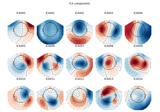mne.preprocessing.corrmap¶
- mne.preprocessing.corrmap(icas, template, threshold='auto', label=None, ch_type='eeg', plot=True, show=True, outlines='head', sensors=True, contours=6, cmap=None, sphere=None, verbose=None)[source]¶
Find similar Independent Components across subjects by map similarity.
Corrmap (Viola et al. 2009 Clin Neurophysiol) identifies the best group match to a supplied template. Typically, feed it a list of fitted ICAs and a template IC, for example, the blink for the first subject, to identify specific ICs across subjects.
The specific procedure consists of two iterations. In a first step, the maps best correlating with the template are identified. In the next step, the analysis is repeated with the mean of the maps identified in the first stage.
Run with
plotandshowset toTrueandlabel=Falseto find good parameters. Then, run with labelling enabled to apply the labelling in the IC objects. (Running with bothplotandlabelsoff does nothing.)Outputs a list of fitted ICAs with the indices of the marked ICs in a specified field.
The original Corrmap website: www.debener.de/corrmap/corrmapplugin1.html
- Parameters
- icas
listofmne.preprocessing.ICA A list of fitted ICA objects.
- template
tuple|np.ndarray, shape (n_components,) Either a tuple with two elements (int, int) representing the list indices of the set from which the template should be chosen, and the template. E.g., if template=(1, 0), the first IC of the 2nd ICA object is used. Or a numpy array whose size corresponds to each IC map from the supplied maps, in which case this map is chosen as the template.
- threshold“auto” |
listoffloat|float Correlation threshold for identifying ICs If “auto”, search for the best map by trying all correlations between 0.6 and 0.95. In the original proposal, lower values are considered, but this is not yet implemented. If list of floats, search for the best map in the specified range of correlation strengths. As correlation values, must be between 0 and 1 If float > 0, select ICs correlating better than this. If float > 1, use z-scoring to identify ICs within subjects (not in original Corrmap) Defaults to “auto”.
- label
None|str If not None, categorised ICs are stored in a dictionary
labels_under the given name. Preexisting entries will be appended to (excluding repeats), not overwritten. If None, a dry run is performed and the supplied ICs are not changed.- ch_type‘mag’ | ‘grad’ | ‘planar1’ | ‘planar2’ | ‘eeg’
The channel type to plot. Defaults to ‘eeg’.
- plotbool
Should constructed template and selected maps be plotted? Defaults to True.
- showbool
Show figures if True.
- outlines‘head’ | ‘skirt’ |
dict|None The outlines to be drawn. If ‘head’, the default head scheme will be drawn. If ‘skirt’ the head scheme will be drawn, but sensors are allowed to be plotted outside of the head circle. If dict, each key refers to a tuple of x and y positions, the values in ‘mask_pos’ will serve as image mask. Alternatively, a matplotlib patch object can be passed for advanced masking options, either directly or as a function that returns patches (required for multi-axis plots). If None, nothing will be drawn. Defaults to ‘head’.
- sensorsbool |
str Add markers for sensor locations to the plot. Accepts matplotlib plot format string (e.g., ‘r+’ for red plusses). If True, a circle will be used (via .add_artist). Defaults to True.
- contours
int|arrayoffloat The number of contour lines to draw. If 0, no contours will be drawn. When an integer, matplotlib ticker locator is used to find suitable values for the contour thresholds (may sometimes be inaccurate, use array for accuracy). If an array, the values represent the levels for the contours. Defaults to 6.
- cmap
None| matplotlib colormap Colormap for the plot. If
None, defaults to ‘Reds_r’ for norm data, otherwise to ‘RdBu_r’.- sphere
float| array_like |str|None The sphere parameters to use for the cartoon head. Can be array-like of shape (4,) to give the X/Y/Z origin and radius in meters, or a single float to give the radius (origin assumed 0, 0, 0). Can also be a spherical ConductorModel, which will use the origin and radius. Can be “auto” to use a digitization-based fit. Can also be None (default) to use ‘auto’ when enough extra digitization points are available, and 0.095 otherwise. Currently the head radius does not affect plotting.
New in version 0.20.
- verbosebool,
str,int, orNone If not None, override default verbose level (see
mne.verbose()and Logging documentation for more). If used, it should be passed as a keyword-argument only.
- icas
- Returns
